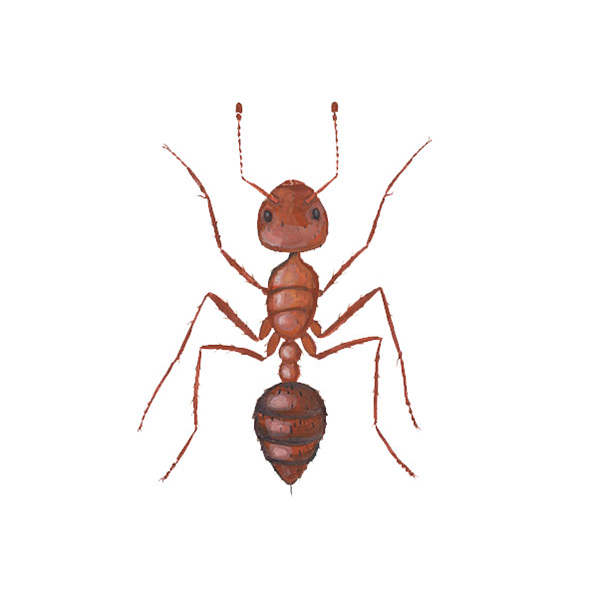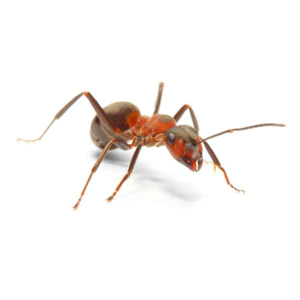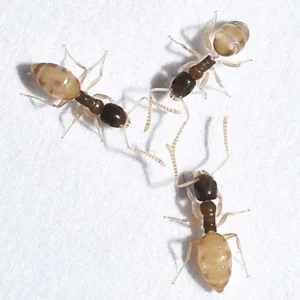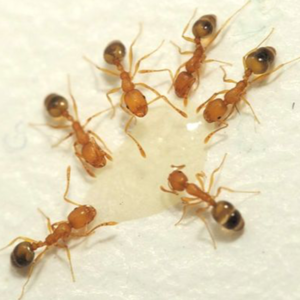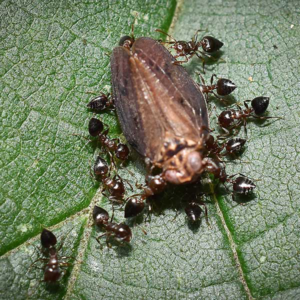Fire Ant Identification
Fire ants are common ants in North Carolina and get their name from their extremely painful sting and bite. One fire ant can sting and bite its victim repeatedly. These ants build mounds, and when a fire ant mound is disrupted, workers make their way to the surface to attack the intruder. Attacks by fire ants are coordinated as hundreds of workers sting at the same time. Feeding on almost any plant or animal material, fire ants also feed on other insects. Additionally, fire ants are attracted to electricity and have been known to destroy anything from AC units and water well equipment to outdoor lighting, creating a fire hazard.
What Do Fire Ants Look Like?
Fire ants are a distinctive and aggressive ant species known for their reddish-brown coloration. They typically range from 1/8 to 3/8 inches in length. These ants are characterized by their coppery-brown head and body with a darker abdomen, which helps in distinguishing them from other ant species.
Signs of a Fire Ant Infestation
Signs of a fire ant infestation include the presence of mound-shaped nests in the soil, often in sunny areas. These mounds can be large, sometimes exceeding 12 inches in height. Additionally, an increase in ant activity, especially near the nest sites, is a clear indicator.
Habitat, Diet, Life Cycle & Bites
Where Do Fire Ants Live?
Fire ants prefer warm, sunny conditions. Attracted to moisture, fire ants they nest near rivers, well-watered lawns, and potted plants. Fire ants build mounds that help to regulate temperature and moisture conditions in the colony. Mounds act as an above-ground nursery and provide excellent temperature and moisture conditions. Their nests or mounds are typically built in the soil and can be found in both rural and urban settings. Undisturbed fire ant mounds are frequently located in sunny open areas, such as pastures, parks, lawns, and fields.
Diet of Fire Ants
Omnivores, fire ants will feed on both plant and animal resources. When foraging for food, aggressive fire ants gain access to homes through cracks, crevices, gaps under doors, windows, or walls. They are also attracted to oily and greasy foods, making them a common pest in and around human dwellings.
Life Cycle of Fire Ants
The life cycle of fire ants includes the stages of egg, larva, pupa, and adult. The queen ant lays eggs, which hatch into larvae. Larvae are fed and cared for by worker ants until they develop into pupae, eventually emerging as adult ants.
Fire Ant Bites
Fire ant bites can be painful and often result in raised red bumps that can become itchy and inflamed. In some cases, bites can cause allergic reactions, which may require medical attention.
Are Fire Ants Dangerous?
Fire ants are considered dangerous due to their aggressive behavior and painful bites.The painful sting of a fire ant is a serious threat to humans and pets. Most venomous ants bite and then spray acid into the wound; fire ants bite and then use their stinger, located on their abdomen. For most people, the burning sensation goes away in a few minutes. However, hive-like bumps occur at the sting site within 30 minutes and pimples with yellow fluid occur within 24 hours after being stung. Large colonies can damage plants, lawns, and outdoor electrical fixtures. Due to the serious threat posed to people and their pets, if a mound is located, it is best to leave it alone and contact a professional ant exterminator.
How to Get Rid of Fire Ants?
Getting rid of fire ants can be challenging due to their aggressive nature and the complexity of their colonies. Treatment often involves baiting and applying insecticides to mounds. For large or difficult infestations, professional pest control is recommended.
Fire Ant Prevention Tips
Prevent fire ants by maintaining a clean yard, removing potential food sources, and regularly inspecting your property for signs of mounds or nests. Seal any cracks and crevices around the exterior of your home to prevent entry.
Need help with Fire Ants control?
FAQs
What Makes Fire Ants Go Away?
Effective fire ant control often requires a combination of baiting and direct treatment of nests with insecticides. Consistent yard maintenance and removal of food sources also help in keeping fire ants away.
What is the Best Defense Against Fire Ants?
The best defense against fire ants is prevention, which includes regular yard maintenance, removing food sources, and treating any visible mounds with appropriate insecticides.
What is the Very Best Fire Ant Killer?
The best fire ant killer typically involves baiting systems combined with direct mound treatments using recommended insecticides. The effectiveness of DIY products can vary, so it’s important to consult with our pest control professionals for the most effective solution – let us help get rid of fire ants for good – contact us today!

